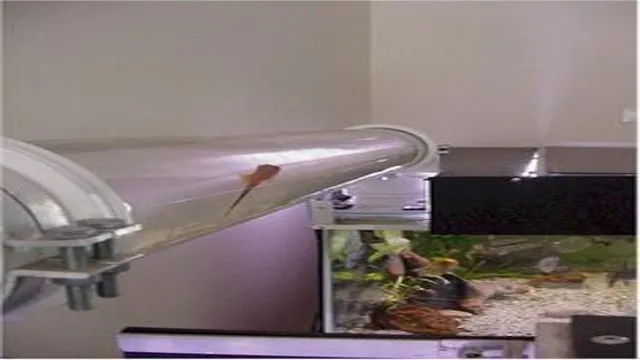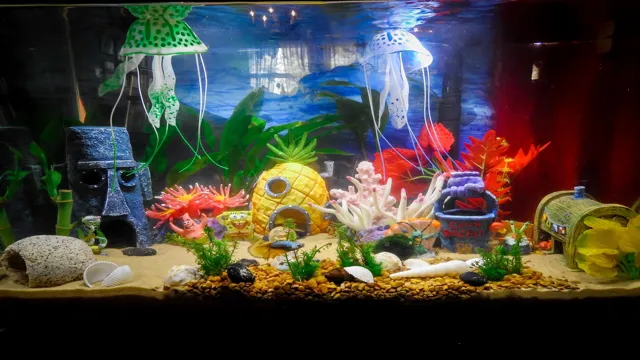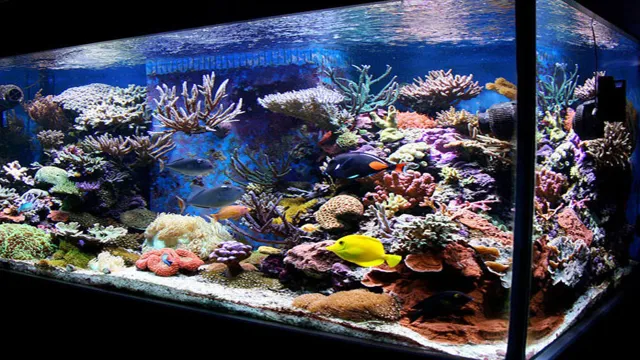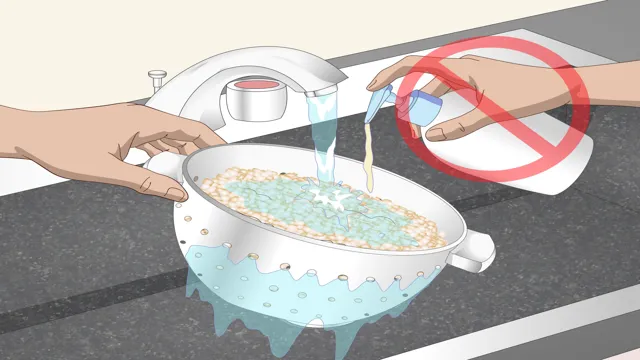Have you ever wanted to create a unique and stunning aquarium that becomes the center of attention in any room? One of the most amazing ways to do just that is by making a water bridge aquarium. Not only is it a great conversation starter, but it’s a beautiful mix of art and science that’s both fun and engaging to make. So, what precisely is a water bridge aquarium? It’s an innovative and visually stunning way to connect two aquariums, creating an elegant bridge that allows water (and fish) to flow freely from one side to the other.
The way the water flows through the bridge is a hypnotic and calming sight to behold. But creating one of these magnificent structures is anything but simple. You’ll need to think about the materials, the sizes of the aquariums, and other vital factors before you even begin construction.
That’s why in this blog post, we’ll guide you through the step-by-step process of creating your very own water bridge aquarium. We’ll tell you exactly what materials you’ll need, how to set them up, and how to maintain the perfect balance for a successful water bridge. So, get ready to become a master aquarium maker, impressing your friends, and creating an unbelievable centerpiece with this exciting project.
Let’s dive in!
Materials Needed
Are you wondering how to make a water bridge aquarium? To create this mesmerizing masterpiece, you’ll need some essential materials. You’ll need a 10-gallon aquarium for each side of the bridge and a bridge that spans across the two aquariums. Other materials include aquarium silicone, a ruler, a pencil, and a level.
You’ll also need two aquarium heaters and filters, substrate, aquatic plants, and some decorative objects to enhance the beauty of your aquarium. A water pump and tubing are required to create the bridge effect. Assembling a water bridge aquarium requires careful attention to detail and patience, so take your time and enjoy the process.
With these materials, you’ll be well on your way to creating your stunning underwater water bridge aquarium.
Heading Three
Heading Three is an important and often overlooked aspect of writing, especially in the blogging world. It is the third level of heading and an opportunity to further break down your content into subtopics. When writing a blog post, it’s important to consider the Materials Needed.
Providing a list of necessary items can be beneficial for your readers who want to follow along with your instructions or replicate your project. For example, if you’re sharing a recipe, it’s important to include a list of ingredients and any necessary tools, such as measuring cups or a blender. If you’re sharing a DIY project, you’ll need to list all the materials required to complete the project, including tools and supplies.
By providing a comprehensive list of Materials Needed, you’ll be making it easier for your readers to follow along with your content and increase their chances of success. Overall, the Materials Needed section is an essential part of any blog post, as it helps to convey the necessary information for your readers to get started on their own projects.

Heading Three
Heading Three: Materials Needed Starting any new project can be a daunting task, especially when it comes to crafting and DIY. Finding the right materials can be tricky, as well as figuring out the quantity required. But fear not, with a little bit of research and some helpful tips, you’ll be crafting like a pro in no time! The first step in determining what materials you’ll need for your project is to consult the instructions or tutorial.
Most guides will list the necessary materials upfront, so you’ll know precisely what you need to get started. It may be helpful to create a checklist and double-check that you have everything on hand before diving in. Next, consider the quality of the materials.
Depending on the project, you may want to invest in higher-end materials that will lead to a better outcome. On the other hand, if you are just starting and don’t want to break the bank, using budget-friendly options can be a smart choice. Consider how frequently you plan on using the materials; if it’s a one-time project, it may not be necessary to splurge on the fanciest options.
Finally, don’t forget to factor in tools! Almost all crafting and DIY projects require some sort of tool, from scissors to power drills. If you don’t have the necessary tools on hand, you may need to invest in them or borrow from a friend. In conclusion, starting a crafting or DIY project can be an exciting, yet overwhelming task. (See Also: How to Make a Fry Trap for Your Aquarium: A Step-by-Step Guide for Keeping Your Fish Safe and Healthy)
The first step in ensuring a successful outcome is to gather all the necessary materials and tools. Take your time, do your research, and don’t be afraid to ask for help. With the right materials and instructions, you’ll be a crafting wizard in no time!
Setting up the Aquarium
If you’re looking to set up a unique and beautiful aquarium, a water bridge aquarium might be just what you need. But before you start, it’s important to have a plan and the right materials. First, decide on the size and shape of your aquarium and purchase the appropriate tank.
Next, you’ll need a sturdy stand to support the weight of the tank. Once you have your tank and stand, it’s time to set up the water bridge mechanism. This involves using two tanks connected by a pipe to create a waterfall effect.
You’ll need to use a pump to circulate the water between the two tanks. It’s important to ensure the water is clean and balanced with the right pH and temperature levels. Finally, add decorations and plants to create a beautiful underwater landscape.
With careful planning and attention to detail, you can successfully create a stunning water bridge aquarium that will leave your guests in awe.
Designing the Bridge
Designing the Bridge Setting up an aquarium can be a fun and rewarding experience. One important aspect of creating a successful aquascape is designing a bridge to connect different areas of the tank. There are many different types of materials and styles that can be used for a bridge, such as rocks, wood, or plastic.
When selecting a material, it is important to consider its durability and how it will interact with the water chemistry. Once the material has been chosen, begin by laying out the path of the bridge and securing it in place with aquarium safe adhesive. An ideal bridge should be stable and provide adequate support for the weight of fish and decorations.
A well-designed bridge can add depth and visual interest to the aquarium, creating a more natural and immersive environment for your aquatic pets.
Plumbing and Filtration
Setting up an aquarium is an exciting task, but it’s important to get it right to ensure the health and happiness of your fish. Plumbing and filtration are crucial components of any aquarium setup, as they help to maintain water quality and prevent the buildup of harmful substances. When setting up your aquarium, it’s important to consider the size and type of your tank, as well as the number and species of fish you plan to keep.
This will help you determine the appropriate plumbing and filtration system for your specific needs. It’s also important to regularly clean and maintain your filters to keep them working properly and prevent any issues from arising. By taking the time to properly set up and maintain your plumbing and filtration system, you’ll be well on your way to creating a thriving aquatic environment for your fish to call home.
Adding Fish and Other Enhancements
After setting up the aquarium, the next step is adding fish and other enhancements. It’s essential to research the specific needs and compatibility of each type of fish you want to house. All fish species have unique requirements, including water temperature, pH levels, and lighting, among others.
Adding live plants can help balance the ecosystem and provide a natural habitat for the fish. Besides, it’s crucial to install a filtration system to maintain water quality and avoid ammonia build-up, which is harmful to your aquatic pets. Before adding any fish, allow the aquarium to establish itself and run for a few days, ensuring that the water parameters are stable.
Unstable water conditions can cause fish stress, leading to diseases and fatalities. Remember to only add a few fish at a time, allowing them to adjust to their new environment.
Maintaining Your Water Bridge Aquarium
If you’re looking for a unique and eye-catching aquarium design, a water bridge aquarium is a great option. This type of aquarium features a bridge or walkway that spans over the water, creating a stunning visual effect. However, maintaining the water bridge aquarium can be a bit more challenging than your typical fish tank. (See Also: How to Kill Black Algae in Aquarium: Quick and Effective Solutions)
It’s important to regularly check water quality, as the bridge or walkway can create areas of stagnation or low oxygen. In addition, the bridge itself should be kept clean and free of any debris or algae to ensure it stays balanced and stable. When it comes to setting up your water bridge aquarium, it’s important to choose the right materials for the walkway and supports and to ensure proper filtration and aeration systems are in place.
Overall, with proper care and maintenance, a water bridge aquarium can be a beautiful and unique addition to any home or office.
Water Quality and Testing
Maintaining Your Water Bridge Aquarium Maintaining water quality in your aquarium is crucial for the health and well-being of your fish and other inhabitants. Regular water testing can help you identify potential problems before it’s too late. You’ll need to track levels of ammonia, nitrites, nitrates, pH, and water hardness.
The easiest way to test water quality is by using testing strips or liquid test kits. Some hobbyists prefer using electronic testers for more accurate readings. Remember to change a portion of your aquarium water frequently to keep the water fresh and clean.
A good rule of thumb is to change 10 to 15 percent of the water every week. The water change also allows for the removal of decaying organic matter, which can contribute to nutrient imbalance. Keep your aquarium filter clean by rinsing it out with aquarium water during water changes.
Monitoring water quality regularly and performing routine maintenance will help your water bridge aquarium thrive. So, aim for a healthy aquarium by testing and maintaining water quality properly.
Cleaning and Maintenance
Maintaining your water bridge aquarium is essential to its longevity and the health of its inhabitants. Keeping the water quality at an optimum level is crucial, and regular cleaning is required to achieve this. First, you should monitor the water temperature regularly to ensure it remains stable, as changes in temperature can harm your fish.
Secondly, you should remove any debris, such as dead plants, uneaten food, or fish waste, using a siphon or a net. This debris can contaminate your water and cause harmful bacteria to grow. Thirdly, changing the water regularly is a must.
You should replace at least 20% of the aquarium water every two weeks. This will eliminate any contaminants that have built up over time. When adding new water, make sure to match the temperature and pH of the existing water.
Finally, regular maintenance of your aquarium equipment, such as filters and pumps, is crucial. By following these simple steps, you can keep your water bridge aquarium in excellent condition so that your fish can thrive.
Troubleshooting Common Issues
Making a water bridge aquarium is a fantastic way to enhance the beauty of your home. However, some common issues may arise during the process. One issue is the water flow.
If the water flow is not adequate, the bridge won’t be able to hold properly, leading to water spills. So it’s necessary to install a powerful pump to keep the water flow just right. Another common issue is algae growth.
Algae can cause the water to look green or hazy, which can be unattractive. To avoid this, you can use proper lighting and filtration to prevent excessive algae growth. Lastly, having a proper maintenance routine is necessary to keep your water bridge aquarium in good condition. (See Also: How to Lower Phosphates in Saltwater Aquarium: Effective Tips and Tricks)
Performing regular water changes and cleaning the tank are effective ways to prevent any problems. With these tips, you can easily troubleshoot and avoid any common issues while making and maintaining your water bridge aquarium. So go ahead and create a stunning water bridge aquarium that will provide relaxation and beauty to your living space.
Conclusion
In summary, creating a water bridge aquarium is a fun and unique way to incorporate aquatic life into your home decor. By utilizing clear tubing and a little bit of creativity, you can craft a stunning and functional masterpiece that will impress all who lay eyes on it. Just be sure to research your fish species and maintain proper water quality to ensure the health and happiness of your underwater friends.
So, what are you waiting for? Dive in and make a splash with your very own water bridge aquarium!”
FAQs
What is a water bridge aquarium?
A water bridge aquarium is a type of aquatic setup that connects two tanks using an overhead bridge, allowing fish and other creatures to move freely between them.
How do you make a water bridge aquarium?
To make a water bridge aquarium, you will need to have two tanks of equal height, a custom-built bridge made of sturdy material (such as acrylic or glass), and a pump system to circulate water between the two tanks.
Can any fish be kept in a water bridge aquarium?
Most small to medium-sized freshwater fish can be kept in a water bridge aquarium, provided that their specific water requirements (such as pH, temperature, and hardness) are met. However, it is important to research the compatibility of different species before adding them to the tank.
How do you maintain a water bridge aquarium?
To maintain a water bridge aquarium, you should regularly clean the tanks and the bridge, test the water quality, and perform partial water changes as needed. You should also monitor the health of your fish and address any issues promptly.
Does a water bridge aquarium need special equipment?
Yes, a water bridge aquarium requires special equipment such as a custom-built bridge, a pump system, and possibly additional filtration or heating. It is important to ensure that all equipment is compatible with the specific design of your setup.
Can a water bridge aquarium be customized?
Yes, a water bridge aquarium can be customized in many ways, such as the shape and size of the tanks, the material and design of the bridge, and the type of fish and aquatic plants that are kept in the setup.
What are the benefits of a water bridge aquarium?
A water bridge aquarium can provide a unique and visually stunning addition to any home or office. It also allows fish to have more space to swim and explore, and can promote a healthier and more natural environment for aquatic life.







